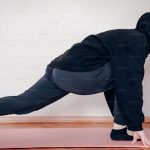Lotus pose. The holy grail of ãsana. In so many Instagram pictures and usually showcased on the mat next to you during class.
But will you get there one day? Maybe, maybe not…
I Have a Dream
Think back to when you started yoga. Which poses did you really want to be able to do? What pose made you feel like a real yogi? I’m betting that Lotus, or Padmāsana, was somewhere in that to-do list. It was certainly on mine.
When you see someone seated serenely in Lotus, their grace and elegance truly belies the enormous physical challenge of the pose. We recognise that the hips need to be ‘open’ but what does that really mean? And what about the other joints that build the pose? Let’s take a look at the building blocks of this beguiling asāna.
You Just Need Open Hips – Right?
You do need open hips to achieve Lotus, but that is by no means the end of the story. Lotus is about teamwork; the body working in balance with each segment contributing its fair share to the end result.
- Spine – There must be enough mobility to maintain a lordosis, or forward curve, in the lower back
- Pelvis – You need freedom in the hips and spine to allow the pelvis to tilt forwards and still maintain grounding through the sit bones
- Hips – Lots going on here – the hips are flexed, abducted and massively externally rotated
- Knees – Flexion, flexion and more flexion plus some external rotation of the tibia, or lower leg
- Feet and ankles – Stiff or sensitive feet and ankles will create additional hurdles
So, Lotus really is so much more than just open hips. If there is stiffness or lack of range of movement in any one of these areas, then Lotus will remain a distant dream. Or worse – if one joint is stiff and limited, then other ones will compensate and over work. This might get you into the pose but brings a real risk of injury in those overworking joints.
The Path to the Perfect Lotus
Much of what stops us from getting into Lotus is soft tissue limitation – tightness in muscles and fascia around joints that prevent the joint moving into its fullest range. And we all know that with dedicated, patient practice this will change. These soft tissues will lengthen in time and we will get steadily closer to our goal.
As a beginner, every asāna will be increasing the mobility in the tissues needed for Lotus. As the body starts to open up, more specific work may be needed –
- Back bends – poses like Cobra, Lunges and Camel will help to lengthen the front of the hips, particularly the big Psoas muscle that can prevent the hips opening wide
- Hip and knee flexion – Happy Baby and Child’s Pose will help to ease tight hips into flexion and target lengthening of short Quadriceps muscles on the front of the thigh
- Hip abduction and external rotation – these movements can be targeted in poses that use a Pigeon leg position – Sleeping Pigeon, any variations of Kapotāsana, Ardha Baddha Padmasana and Firelog are all wonderful ways of getting into the buttock and hip structures in preparation for Lotus
- Foot and ankle – Child’s pose and upright kneeling with buttocks on heels and toes pointed help to stretch the foot and ankle
When working to lengthen the soft tissues, i.e. the muscles and fascia of the body, it is vital to be patient and listen to your body. It is so easy to over stretch and damage the very tissues that you are trying to lengthen. In your practice, always aim for a comfortable sensation of stretch that stays the same or eases as you hold the position. Never push into pain or an increasing sensation of stretch.
Read more about safe stretching here – The Science of Stretching
When Your Anatomy Gets in the Way
While patient stretching of soft tissues in a safe, mindful way will reap benefits in most people, there are some instances where it won’t work. We are not all built exactly the same and one of the wonderful ways in which we differ is in our skeleton. Our bones are NOT the same. My hips are different than yours; your spine will differ from the yogi next to you; their ankle is a different shape to their sister, and so it goes.
Sometimes a particular shaped bone in a joint means you get lucky and can move that joint further than other people. So maybe you go further in Backbend or Forward Fold. On the other hand, a different shaped bone may mean you will never get into a certain position. Our hips are like that in Lotus.
The hips are made up of the rounded top-end femur, or thigh bone, which sits in a socket on the pelvis called the acetabulum. Some acetabulums point a more forwards than others, some point down and others more to the side. There are also a wide range of different shapes that the end of the femur can be. The combined shapes of these two bones that a person has will contribute to how much the hip joint can move in certain directions. Some combinations will suit Lotus and others will not.
Another limiting factor is soft tissue bulk – be that muscle or not. if you have bulky calves and thighs then your knee will not be able to bend as far as if you have a leaner build. This could be the difference between achieving Lotus or not for some people too.
Acceptance is the Way Forwards
I think I have one hip that might get into Lotus one day and the other that is definitely not going to. How do I know? Well, they feel different in certain positions – one hurts, the other doesn’t. When you find that lovely sweet spot of stretch that eases up and allows you to move deeper into the pose, then your body is telling you that you will continue to gain range of movement in that direction. Hurrah!
But you may feel a block. Or a pain. Often, a nipping or compressing feeling in the joint is your body’s way of telling you ‘NO! The path is closed in this direction – do not push me further. Something is in the way.’ In Lotus, this may be your hip or your knee or even your ankle – but wherever it is – LISTEN and accept that the full expression of Lotus may not be for you. Pushing into that block risks damaging your body and that is not what yoga is about.
Not all of us will be able to achieve Lotus. But that is yoga. Celebrate that every yogi is different – it would be SO BORING if we were all the same.













